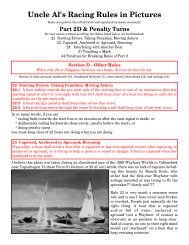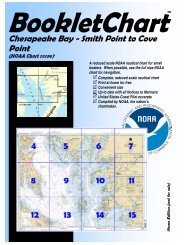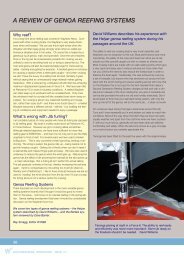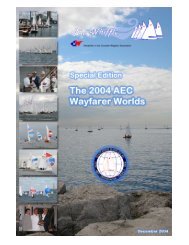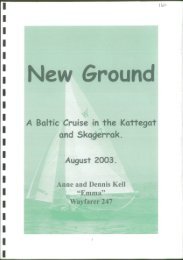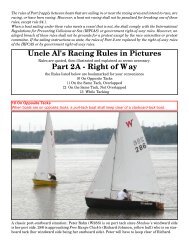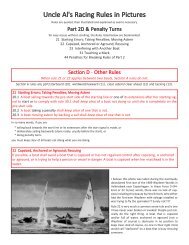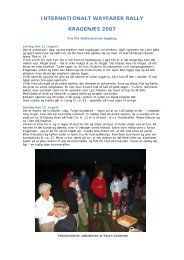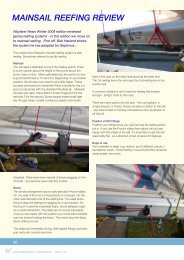Contents - Wayfarer Institute of Technology
Contents - Wayfarer Institute of Technology
Contents - Wayfarer Institute of Technology
Create successful ePaper yourself
Turn your PDF publications into a flip-book with our unique Google optimized e-Paper software.
polluted, you are never going to die <strong>of</strong> thirst. Where the<br />
lake water is drinkable, you need carry only enough for 24-<br />
48 hours, which you may need at a campsite where the<br />
local water is unfit for drinking. Replenish your water containers<br />
when you are out on open water. In more populated<br />
areas, carry enough for three or four days, as not all<br />
places where you camp will have good water. Two or three<br />
smaller containers are better than one large one, for ease<br />
<strong>of</strong> handling.<br />
Flashlights and Spare Batteries. Even for a one-day sail,<br />
carry a flashlight. For a camping trip you need two or<br />
more. The right-angled kind that clip on to the belt are<br />
very handy. It is convenient to use the same size <strong>of</strong> battery<br />
for flashlights, radio (if carried), running lights etc. Fewer<br />
spares need be carried this way.<br />
Whistles. A whistle that will not break (and that has been<br />
tested when wet) should be carried by each person in case<br />
he falls overboard, or gets lost or injured in the bush when<br />
ashore.<br />
Knives. Every sailor should carry a knife, preferably with<br />
marlin-spike and shackler, for many everyday uses. Once in<br />
a lifetime you may have to cut a line fast in emergency, so<br />
it should be sharp, always. (Also it is more useful that way,<br />
every day.)<br />
Chapter 4: Rigging and Sails<br />
THE stresses on the rigging when cruising are usually less<br />
than when racing. The wear, though, during a long cruise,<br />
is much greater, and so is the tendency <strong>of</strong> fastenings to<br />
work loose. Turnbuckles should be tightened and wired, or<br />
replaced with lanyards, or perhaps bypassed with a lanyard,<br />
in case <strong>of</strong> failure <strong>of</strong> the tumbuckle screw. Shrouds<br />
and forestay must be examined and if any single wire is<br />
broken or badly kinked, the shroud should be replaced.<br />
One <strong>Wayfarer</strong> sailor doubles his shrouds for ocean cruising.<br />
All screws, bolts, rivets, tangs etc. on the mast must be<br />
checked, and replaced or repaired if damaged. Cotter pins<br />
should be taped. Your masthead pennant will be up there<br />
for the duration <strong>of</strong> the cruise, so make sure it will not work<br />
loose. Check the bow fitting and make sure it is secure.<br />
Look at the chain plates and their fastenings to the hull or<br />
knees. Weaknesses in the attachments <strong>of</strong> the standing rigging<br />
may be very difficult to correct, and that may be the<br />
designer's or the builder's fault, but the safety <strong>of</strong> boat and<br />
crew is the sole responsibility <strong>of</strong> the skipper. In the event<br />
<strong>of</strong> failure <strong>of</strong> a fitting, and a consequent disaster, it is not<br />
<strong>of</strong> the slightest value to be able to blame someone else. So<br />
weaknesses have to be corrected before you start.<br />
Check spreaders and spreader fittings; tape their outer<br />
ends and anyplace where the sail is going to chafe.<br />
Spreaders are important for the security <strong>of</strong> the mast and if<br />
one comes adrift, sail must be shortened immediately to<br />
reduce lateral stresses. Look closely at the mast step,<br />
pivot, and tabernacle, and strengthen if necessary. Also<br />
examine the rudder and centreboard for cracks, and make<br />
sure their fastenings, pivot bolt, and pintles are secure.<br />
If you anticipate lowering the mast while on the water, it<br />
may be worth splicing a rope tail to the forestay and leading<br />
it through a block or smooth shackle back to a stout<br />
cleat behind the wave breaker that you can reach from the<br />
cockpit. Then you can lower the mast without going on the<br />
foredeck, provided that the lowest two piston hanks <strong>of</strong> the<br />
jib are not attached (they will foul the rope-tail splice).<br />
Incidentally, and this is a heavy weather problem, if you<br />
have to take the jib down and sail under main alone, make<br />
sure you tack down the jib halyard to the bow fitting so<br />
that you have, in effect, a double forestay. It may prevent<br />
a broken mast!<br />
For halyards we prefer rope to wire, because wire can<br />
wear the sheave, and can jump <strong>of</strong>f it and jam. The rope<br />
should be durable yet keep stretch to a minimum. We take<br />
a spare length <strong>of</strong> line long enough for a main halyard. We<br />
also carry and reeve the spinnaker halyard, even though<br />
we do not usually carry a spinnaker when cruising. The<br />
spinnaker halyard can stand in for a jib halyard or replace<br />
a broken shroud, provided one uses reduced sail. It is also<br />
handy for hauling up the laundry.<br />
Sails. During most <strong>of</strong> the cruise, there will be either<br />
enough wind or too little, and for both cases you will want<br />
your full racing sails. The dinghy will be more heavily<br />
laden, and it would be a mistake to go <strong>of</strong>f with small sails<br />
just because you are cruising.<br />
Mainsail. A cruising mainsail can be simplified by dispensing<br />
with battens. The only purpose <strong>of</strong> battens is to prevent<br />
leach flutter in a sail cut with a large roach and the only<br />
purpose <strong>of</strong> the roach is that extra tenth <strong>of</strong> a knot when<br />
racing. You lose very little speed by cutting <strong>of</strong>f" about twothirds<br />
<strong>of</strong> the roach, and dispensing with battens.<br />
Leave a little roach, or you get a light leach. A sail-maker<br />
would do this for you, but on our <strong>Wayfarer</strong> mainsail, we<br />
did it ourselves and came out with a sail that sets well. We



